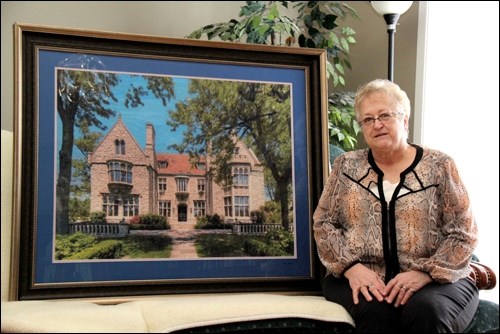Henriette Schultz, formerly of Debden, recently completed a magnificent commissioned cross-stitch replica of a castle located in Buffalo, N.Y.
Having only learned the art of cross-stitch in 2005, Schultz is incredibly skilled in the art form and has a unique talent for creating realistic portraits, designs and scenery, capturing the true essence of the subject.
This particular counted cross-stitch project took 2,340 hours to complete and is comprised of 185,976 stitches. The framed masterpiece measures almost four feet, 45.5 inches, wide and over three feet, 37.5 inches, high. The first stitch was cast Feb. 10, 2014, and the final stitch, completing the project, was made Feb. 3, 2015. This commissioned masterpiece, purchased by Al and Donna Haid of Burlington, Ont., is the third in the couple’s collection.
“Both were unique in their own way but neither as grandiose as this castle was,” explained Schultz.
Cross-stitch is a media that lends itself to the detail relevant in architectural structures and portraiture of pets and people.
The entire picture is stitched on 14-count aida cloth, using two strands of DMC floss for each stitch. The floss corresponds to a computer generated symbol chart. Cathy Hoffman assisted Schultz in obtaining the chart, using a scanner, computer program and printer to generate the grid.
The desired photograph is scanned and the installed computer software produces a symbol chart, indicating all the colours of floss required for the project along with a workable grid. The computer enables her to enlarge the picture to the desired size. The blueprint gives detail and practically any image can be converted into a custom cross-stitch pattern.
Schultz draws the grid onto the aida cloth using a washable marking pen. The challenge begins when 100 different shades are required and need to be organized. The floss is categorized according to symbols and stored on a convenient floss organizer. Another organizer keeps multiple threaded needles available eliminating the need to rethread just one needle. A conversion chart between yarn companies can be accessed, enabling her to maximize her inventory.
The count of the fabric determines the size of the finished stitching. A small number count accentuates details creating a multi-dimensional effect. Schultz’s skill and technique, combined with the grid size, captures the reflection of the trees in the windows and the textured stones on the wall. This creates a life-like illusion that one could reach into the picture and actually feel the texture of the wall.
Each project provides a learning curve. With this project, the learning involved Schultz’s prescription progressive lenses.
“Progressives are less favourable for such extensive detailed cross-stitch projects. My bifocals were much more accommodating to my needs,” said Schultz, explaining that with bifocals she just had to move her eyes whereas with progressive lenses she had to move her entire head position in order for her eyes to focus clearly on the stitches. Bifocals offer a definitive line favourable for close-up projects.
Besides witnessing the satisfied reaction of the customer, Schultz shares that a portion of her reward comes from seeing what the framer comes up with. Frames are used to aesthetically enhance the work of art and protect it from dirt, dust and handling. This controlled setting is essential for ensuring the life of the piece and maintaining its value.
“Vincent Ng of Prince Albert Hobby Craft does an impressive job of accentuating the focal points with the matt and frame selections,” said Henriette.
The detail of the thousands of tiny cross-stitches, hand sewn by Henriette, and the striking resemblance of the finished cross-stitch picture is awe-inspiring. It is not just a picture but rather a living legacy for families.
When asked if she would tackle another large project, she replied without hesitation, “Yes, it is rewarding to complete a commissioned piece that wows the client while allowing me to challenge and expand my skills. It is always an interesting challenge to change subject matter from scenery, portraits and buildings.”




